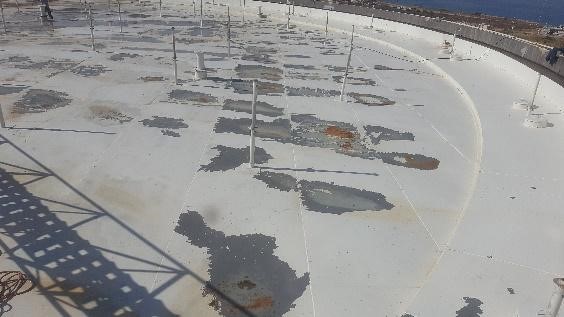Background:
The Client is an energy infrastructures company providing storage, transport services and port services for energy products for domestic and foreign customers. The company was established in 1968 and has dozens of large volume steel tanks. The proximity to the seashore and to a coal-based electricity facility are responsible for accelerating the rusting process and for more frequent maintenance.
Since January 2017, a new system of paints has been used during maintenance. It includes the Corrizon Base as a base layer which protects the metal against corrosion and treats corroded surfaces. The tested area was 1500m2and could not be sandblasted. The preparations only included high-pressure water jetting; it was not required to remove old paint nor were there any other common surface preparations required. The whole project took less than ten days.
The Challenges:
Corrosion is one of the most important aspects of maintaining vessel safety together with preserving asset values.

Untreated areas can lead, over time, to expensive complex maintenance and steelwork replacement and in extreme cases, could result in structural integrity failure and have a severe environmental impact. Hydrocarbon storage tanks have inspection and maintaining routines of their own.
Surface preparations required abrasive blasting, but new regulations prohibit such treatments during maintenance, so a new solution needed to be found. Storage tanks located on shore and coal ash from electricity power plant chimneys located near the tanks, accelerate the corrosion process and increase the frequency of maintenance. Such a project takes time and has high costs
The Process:
The surface of the float roof was cleaned by high pressure water jetting (over 500 bar) to remove old paint and loose metal. Once the area was dry, Corrizon Base was applied by airless spray over the old paint.

The required WFT was 50 microns. Corrizon Base has white-off white color (the old top paint was white).
A pigment was added to the product to verify that all surfaces had been coated. After 24 hours, a new polyurethane top paint layer was applied to complete the customer paint system requirements.
Gloves and protective glasses were the only personal protective equipment required – even respiratory masks were not necessary.
The Results:
After over a year, the floated roof is in excellent condition. There is no sign of rust or paint lamination. Also, the DFT remains the same and the adhesion is very good.
According to the maintenance manager and the inspector:
“After more than a year, the floated roof was inspected and there is no sign of corrosion on the base metal. We also applied it over different surfaces in the plant and the results were also very good”.

